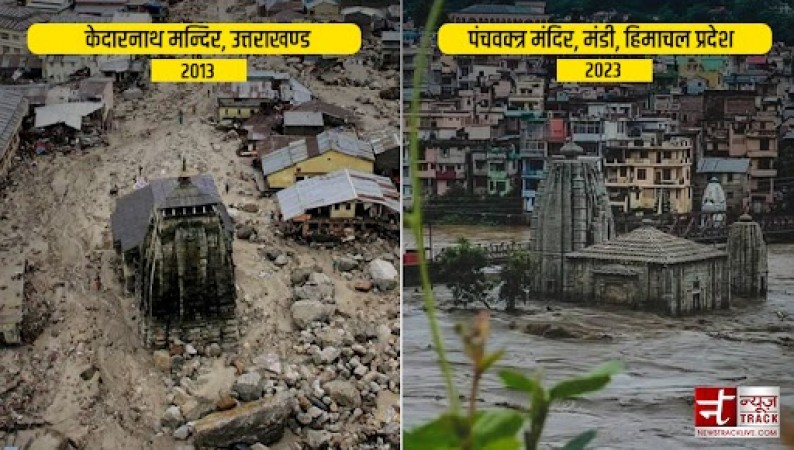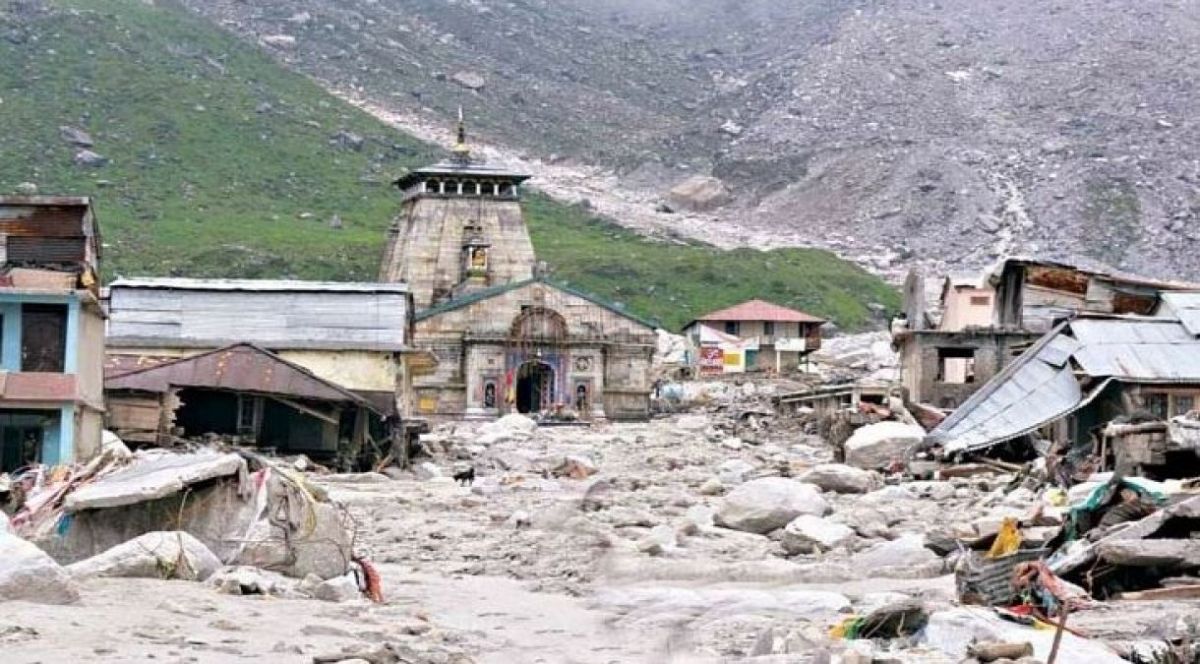
The disaster that is raining over Himachal Pradesh. It is exactly the same as it was 10 years ago on June 15-17, 2013 at the time of Kedarnath accident. Several videos are viral on social media in which the raging rivers can be seen carrying away everything. But even in the midst of this deluge, the 300-year-old Shiva temple at Mandi in Himachal Pradesh is still standing. This temple has reminded the people of the Kedarnath disaster of 2013 when the temple remained safe even in the midst of such floods. There were heaps of dead bodies in this catastrophe. Thousands of people had died. While thousands of people had gone missing, nothing has been found even today. In the face of the devastating floods and landslides that hit Kedarnath in 2013, a symbol of unwavering strength and resilience emerged – the Kedarnath Temple. Located at an altitude of 3,583 meters (11,755 ft) in the Garhwal Himalayan range of Uttarakhand, India, the Kedarnath Temple is one of the most revered Hindu pilgrimage sites. Dedicated to Lord Shiva, it is believed to have been built by the Pandavas of the epic Mahabharata. Nestled amidst the mesmerizing natural beauty of the Kedarnath Valley, the remote location of the temple adds to its mystical aura and spiritual charm.
Two pictures of Mahadev's miracle in the midst of tragedy: -
Kedarnath Temple (2013):-

Panchvaktra Temple (HP 2023)
Strike of Disaster:-
In June 2013, torrential rains and subsequent flash floods ravaged Kedarnath, leaving behind a trail of destruction. Buildings were swept away, bridges collapsed and landscapes changed. As the region grappled with unimaginable devastation, the existence of the Kedarnath temple stood out as a beacon of hope and resilience amid the chaos. The Kedarnath temple, though untouched by disaster, has managed to withstand the ferocious forces of nature. The temple complex, including the main temple, remained intact, defying the overwhelming power of the deluge that engulfed the surrounding areas. Many devotees and locals attribute the survival of the temple to divine intervention and consider it as proof of Lord Shiva's protection. The unwavering faith and reverence attached to the holy site has been a source of solace and inspiration to the affected communities.
Reason for this tragedy:-
The Kedarnath tragedy was the result of a complex interplay of various factors. While natural disasters are inherently difficult to predict and prevent, a few elements exacerbated the scale of destruction in this particular case. Some major contributing factors include:
* Unprecedented rainfall:- The region received an unprecedented amount of rainfall, which was much higher than the average monsoon rainfall. The flash floods overwhelmed natural drainage systems and flooded rivers and streams.
* Cloudburst:- Cloudburst is a meteorological phenomenon characterized by intense and localized rainfall within a short period of time. A cloudburst near Kedarnath further increased the intensity of the rainfall, resulting in devastating floods.
* Geological Vulnerability:- The Himalayan region is known for its geological instability. The steep slopes and fragile rocks make it vulnerable to landslides, especially during heavy rainfall. The combination of excessive rainfall and unstable terrain greatly increases the risk of landslides and subsequent damage.
* Unregulated Development:- The haphazard construction of buildings, hotels and other infrastructure without proper adherence to safety guidelines and environmental considerations has added to the impact of the tragedy. Unrestricted development in the area compromised natural drainage systems, obstructed river courses and worsened the consequences of the disaster.
Results and Rehabilitation Efforts:-
After the Kedarnath tragedy, the focus shifted to rescue and rehabilitation operations. The loss of countless lives and extensive damage to infrastructure required immediate and coordinated efforts from various stakeholders. Here are some key aspects of the rehabilitation process:
* Rescue operations:- Government of India, armed forces and several organizations mobilized quickly to rescue the trapped persons and provide medical aid. The heroic efforts of the rescue teams saved many lives, demonstrating the resilience and compassion of humanity in the face of adversity.
* Reconstruction and development of infrastructure:- Reconstruction of broken infrastructure was an important task. The government allocated significant resources to rebuild damaged roads, bridges and buildings while ensuring compliance with safety regulations. The focus was also on increasing the region's resilience to future disasters through better planning and disaster management strategies.
* Ecological Conservation: Recognizing the ecological fragility of the area, concerted efforts were made to restore the natural balance and prevent further degradation. Afforestation initiatives, soil conservation measures and sustainable tourism practices were implemented to protect the fragile ecosystem and around Kedarnath.
Learning from Tragedy: Strengthening Disaster Preparedness
The Kedarnath tragedy served as a wake-up call, underscoring the need for robust disaster preparedness and mitigation measures. Lessons learned from this devastating event have prompted officials and communities to prioritize the following:
Early warning systems: Investing in advanced meteorological and hydrological monitoring systems can provide timely alerts, allowing communities to evacuate and reduce loss of life.
Resilience of infrastructure: It is important to build buildings and infrastructure that can withstand natural disasters.
Himachal Pradesh:-
Panchvaktra Shiv Temple in Mandi, Himachal Pradesh.
— Anshul Saxena (@AskAnshul) July 10, 2023
At least 13 landslides & 9 flash floods reported in last 36 hours. pic.twitter.com/Dfr7Yg6BXz
Now if the same thing is said about Himachal Pradesh, then in Himachal Pradesh also, in the midst of the deluge, the 300 years old Shiva temple of Mandi in Himachal Pradesh is still standing. So far the state has suffered a total loss of 4000 crores. 20 people have died due to landslides and floods. Instructions have been issued to all administrative officers to remain alert for the coming 10 days. Helicopter help is being taken at many places for relief and rescue operations. About 229 tourists are reported to be stranded in Kullu including Lahaul Spiti and Chandratal areas, efforts are being made to evacuate them safely.
The survival of the Kedarnath Temple and the historic Panchvaktra Temple amidst the deluge is testimony to its enduring spiritual significance and the resilience of the human spirit. It acts as a beacon of hope, inspiring individuals to overcome adversity and rebuild their lives after a disaster. The existence of the temple is a reminder of the deep connection between faith, culture and the ability to face the forces of nature.
Brahmaputra River: Exploring its Hindu Significance and Cultural Importance
"From Filth to Freshness: The Clean India Movement Revolution"
The Divine Godavari River: Exploring Hindu Aspects and Sacredness